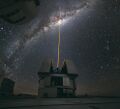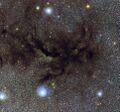Astronomy:Pipe Nebula
| Dark nebula | |
|---|---|
 Pipe Nebula (Barnard 59 is the mouthpiece) | |
| Observation data: J2000 epoch | |
| Right ascension | 17h 27m |
| Declination | −26° 56′ |
| Distance | 600 to 700 ly (180 to 220 pc) |
| Apparent magnitude (V) | – |
| Apparent dimensions (V) | Pipe Stem 300′ × 60′ Pipe Bowl 200′ × 140′ |
| Constellation | Ophiuchus |
| Physical characteristics | |
| Radius | – ly |
| Absolute magnitude (V) | – |
| Notable features | – |
| Designations | Barnard 59, 65–67, & 78; LDN 1773; LDN 42 |
The Pipe Nebula (also known as Barnard 59, 65–67, and 78) is a dark nebula in the Ophiuchus constellation and a part of the Dark Horse Nebula. It is a large but readily apparent smoking pipe-shaped dust lane that obscures the Milky Way star clouds behind it. Clearly visible to the naked eye in the Southern United States under clear dark skies, but it is best viewed with 7× binoculars.
The nebula has two main parts: the Pipe Stem with an opacity of 6 which is composed of Barnard 59, 65, 66, and 67 (also known as LDN 1773) 300′ x 60′ RA: 17h 21m Dec: −27° 23′; and the Bowl of the Pipe with an opacity of 5 which is composed of Barnard 78 (also known as LDN 42) 200′ x 140′ RA: 17h 33m Dec: −26° 30′.

Gallery
The Milky Way between Sagittarius and Scorpius: the Pipe Nebula is visible slightly above and left of center.
View of the Milky Way and the Great Rift from ESO's Very Large Telescope in Cerro Paranal, Chile. The laser beam points almost directly toward the Pipe Nebula.
Two baby stars within the interstellar dust of the Pipe nebula.[1]
References
- ↑ "A Cosmic Pretzel - Twin baby stars grow amongst a twisting network of gas and dust" (in en). https://www.eso.org/public/news/eso1916/. Retrieved 4 October 2019.
 |




